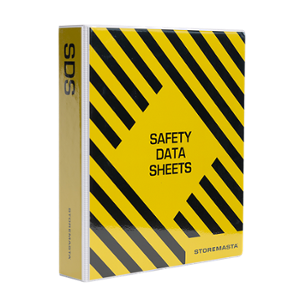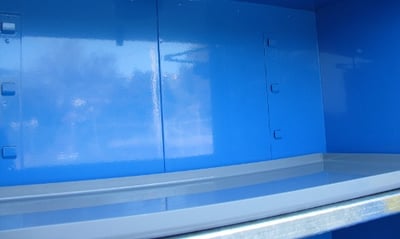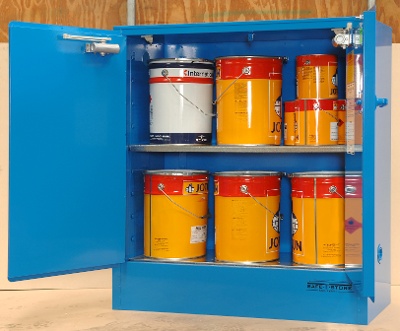If you’re storing corrosive substances in your workplace, you might be considering the type of cabinets that you’ll need. Due to their ability to corrode metals, living tissue and other materials, Class 8 Corrosive Substances have unique handling and storage requirements when compared with other classes of dangerous goods. For indoor storage, corrosives can be stored in either a metal corrosive storage cabinet — with a PVC spill tray on the shelves and in the spill sump — or a polyethylene storage cabinet. But how do you determine what corrosive storage cabinets you’ll require? this post, we list the features that apply to corrosive substances, so you can determine what storage will be suitable for your hazardous chemical products.
Why Do Class 8 Cabinets Have Different Construction Materials?
Corrosive cabinets can be constructed with double-walled steel or a high density polyethylene.
The reason behind these different construction materials is simple: Some corrosive substances may only corrode a cabinet when they leak or spill, while other substances can corrode a cabinet through the emission of corrosive vapours.
What Chemicals Should Be Stored In Each Type of Cabinet?
To determine the corrosive nature of your chemical products, you’ll need to refer to the Safety Data Sheet (SDS) for each chemical that you are considering storing.
REMEMBER: The pH level of your corrosive chemicals determines how corrosive the substance is. Highly corrosive substances pose extreme risk to people, property and the environment. Great care must be taken when your organisation orders any type of highly corrosive substance due to the risks associated with its use.
Your SDS will provide you with the guidelines for storage that applies to each particular corrosive substance that you carry. Section 9 of the SDS will give you the information regarding the pH levels of your substance. However, you should also refer Sections 7 and 10 as this will assist you with determining incompatible materials for storage. For example, you will get guidance on the corrosion resistant materials required for chemical containers and storage.

Consider the pH level and chemical concentration of your products before you select your indoor storage.
If your corrosive substances don’t pose a risk of corrosion through vapour emissions (meaning they are of a less corrosive nature), you can select a metal corrosive cabinet that’s equipped with poly spill trays and sump lining.
Conversely, if your chemicals are classed as highly corrosive, with the ability to emit damaging corrosive vapours, you will have to choose a poly cabinet for your indoor chemical store.
The polyethylene cabinet won’t be subject to chemical attacked by the vapours, as the steel cabinet would be.
 When it comes to dangerous goods storage, you must always refer to the SDS for each chemical product that you’re looking to store.
When it comes to dangerous goods storage, you must always refer to the SDS for each chemical product that you’re looking to store.
What Can Be Stored?
Certain chemicals can be stored in metal cabinets, while others are more suitable for storage in poly cabinets.
Types of corrosives that can be stored in a metal corrosive storage cabinet may include:
Corrosives with a pH level closest to neutral – such as sodium bicarbonate, sodium chloride, hypochlorous acid
Types of corrosives that must be stored in a polyethylene storage cabinet may include:
Acids – including nitric acid, hydrochloric acid, sulphuric acid
Alkali – including calcium hydroxide, potassium hydroxide, sodium hydroxide
REMEMBER: The concentration of the chemical, as well as its pH level, will determine how corrosive the product is. This will affect how you should be storing your chemicals.
Why Is Steel A Good Choice For Safety Cabinets?
As a strong, durable and non-combustible material, steel is often used for the construction of chemical storage cabinets. Steel corrosive cabinets, however, differ from other classes of cabinets due to the fact that the cabinet must be equipped with spill trays (on the shelves and in the bottom of the sump) to prevent chemical attack.
Metal corrosive storage cabinets (along with many other classes of other safety cabinets) feature a double-walled steel construction and thermic air barrier. This air barrier assists in protecting the stored chemicals from excessive heat and flames — in the event of a workplace fire.
As you can imagine, steel provides an excellent protective shell for the stored chemicals. This assists in reducing the likelihood of impact damage, as well as ensuring a long-lasting storage solution. Metal corrosive cabinets are powder coated to maintain the integrity of the sheet steel construction.

Metal cabinets are lined with PVC spill trays on the shelves and in the sump.
Why Select A Poly Corrosive Cabinet?
Even though it is technically a polyolefin resin, high density polyethylene offers excellent strength and durability when it comes to safety cabinet construction.
The cabinets are fabricated and welded from 15mm high density polyethylene, which has been tested by CSIRO for chemical resistance.
Due to the highly corrosive nature of some Class 8 products, the cabinets are constructed metal free – with integral pivot pins instead of metal hinges.
 Poly corrosive cabinets are fabricated and welded from high density polyethylene 15mm thick.
Poly corrosive cabinets are fabricated and welded from high density polyethylene 15mm thick.
Features Of Corrosive Storage Cabinets
Whether you choose a steel or poly cabinet, there are some similar features of a corrosive cabinet.
These features include:
- Doors Open Outwards – Cabinet doors are prohibited from opening inwards. They can also be opened from inside the cabinet
- Signage - Compliant safety signs and directions that ( AS 1216 and AS 1319)
- Provision For Ventilation - Flash arrestors and vent openings for mechanical ventilation system installations
- Australian Standards - Cabinets are designed and manufactured in full conformance to AS 3780:2008 - The storage and handling of corrosive substances
Metal Corrosive Cabinet Construction
Steel cabinets for the storage of Class 8 substances are manufactured with the following design and construction features:
- Steel Construction - Double walled sheet steel construction, with a 40mm thermic air barrier
- Powder Coat Finish – Offering excellent durability and protection
- Adjustable, Perforated Shelving - Strong fully adjustable steel shelving perforated for free air movement, in 100mm adjustment increments
- Shelf Spill Trays - PVC spill trays on shelves to prevent corrosion with leaking chemicals
- Spill Containment - Liquid tight sump (150mm deep) to contain corrosive chemical leaks and spills with a PVC tray
- Door Closing System - Self-closing, close fitting sheet steel doors which are held shut by catches at two points.
- Sequentially Closing Doors – cabinet doors close in sequence. Stainless steel pin for reliability and strength.

Metal cabinets feature perforated steel shelves which can be easily adjusted.
Features Of A Class 3 Poly Cabinet
The risk control measures of a poly cabinet that differ from the steel model include the following design and construction features:
- High Density Polyethylene Construction – Cabinet is manufactured with virgin UV-stablised HDPE (the purest form of polyethylene) in a fully welded construction
- Door Closing System – Self-closing, close-fitting polyethylene doors with corrosive resistant latch (no metallic components) and elastic closer straps
- Adjustable, Perforated Shelving - Strong fully adjustable polyethylene shelving perforated for free air movement, in 100mm adjustment increments
- Segregation barrier and separate spill containment sumps – larger models are equipped with a segregation barrier, as well as separate spill containment sumps, so you can segregate your corrosive acids from your alkalis and bases.
IMPORTANT: Corrosives cabinets made from polyethylene are constructed with dual compartment cabins. This enables corrosive acids and bases to be stored within the same cabinet. Always check your SDS for each product before you fill your cabinet to ensure that substances won’t react dangerously without segregation.
Ventilation
If your store requires ventilation, both types of Class 8 cabinets have the features necessary for the installation of a mechanical ventilation system.
While the Australian Standards for corrosive storage (AS 3780:2008) don't stipulate that a mechanical ventilation is a necessary requirement for corrosive cabinets, they do state that there must be adequate ventilation wherever corrosives are kept.
If you conduct a risk assessment in your work area — and determine that the concentration of hazardous vapours is above the acceptable level — then your cabinet (regardless of whether it's a metal or poly cabinet) needs mechanical ventilation.
IMPORTANT: The workplace exposure standards explain the legal limits for hazardous vapour emissions in your chemical stores. Refer to the standards during your risk assessment, to find out if the vapour emissions are within the Australian limits.
Regardless of whether you choose a metal or poly cabinet, you can install a compliant mechanical ventilation system on your indoor store. Corrosive cabinets are equipped with vents and flash arrestors. These features allow for the mechanical ventilation system to be successfully installed, so you can remove concentrated levels of corrosive vapours from your indoor stores.
Choosing A Safety Cabinet For Your Corrosives
Whether you’re storing acids, bases, alkali chemicals or other Class 8 substances, there are suitable options available for the storage of corrosive substances. Always start with a risk assessment of your area and familiarize yourself with the chemical properties and incompatibilities of your substances.
Would you like to learn more about reducing risk with Class 8 chemicals and other dangerous goods? Our eBook is designed to make your work life easier, with practical advice on how you can reduce risk with all 9 different classes of dangerous goods. Whether you’re storing corrosives, or a variety of different chemical classes, our free guide will help you stay safe and compliant.
Grab your own copy of our guide today by simply clicking on the image below.
Joining the team as a Dangerous Goods Storage Consultant, Melissa Hampton became Storemasta's Marketing Manager in late 2021. With extensive knowledge and experience in chemical compliance, Melissa is responsible for leading the Marketing team and helping shape their marketing strategy. In her spare time, you can find Melissa hiking, swimming and enjoying the great outdoors in beautiful north-west Tasmania.
